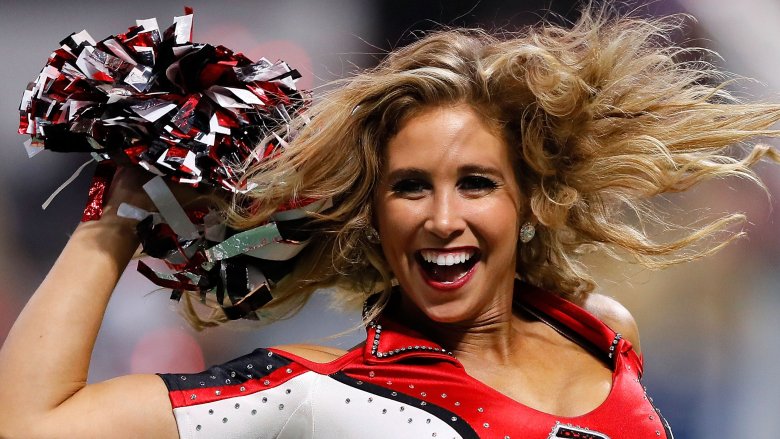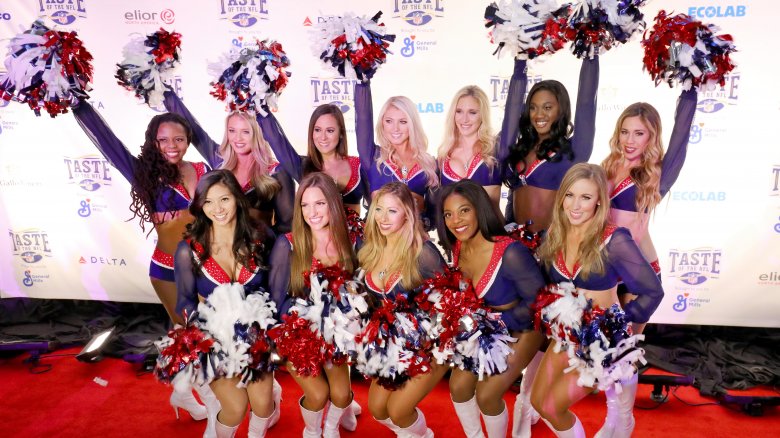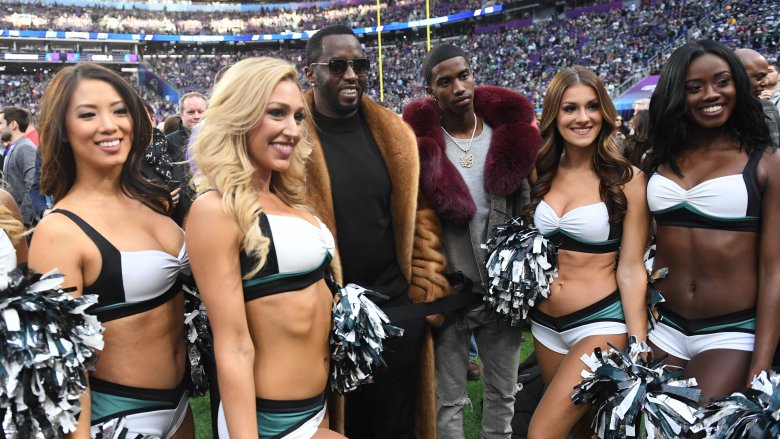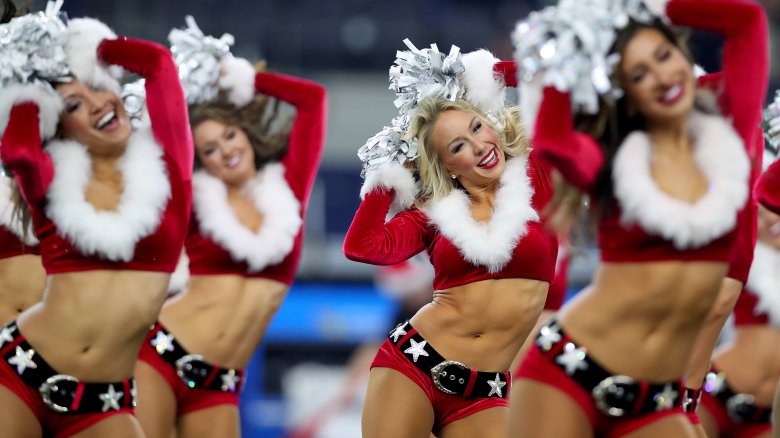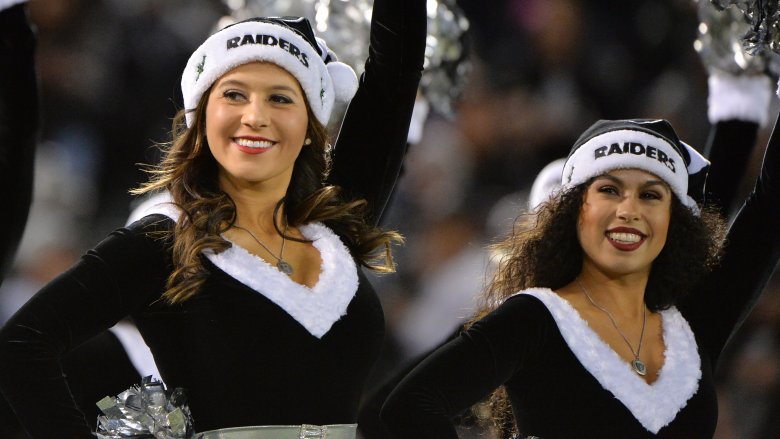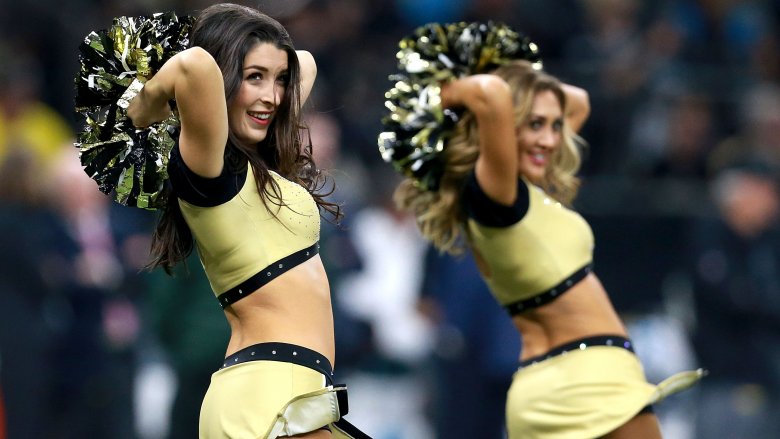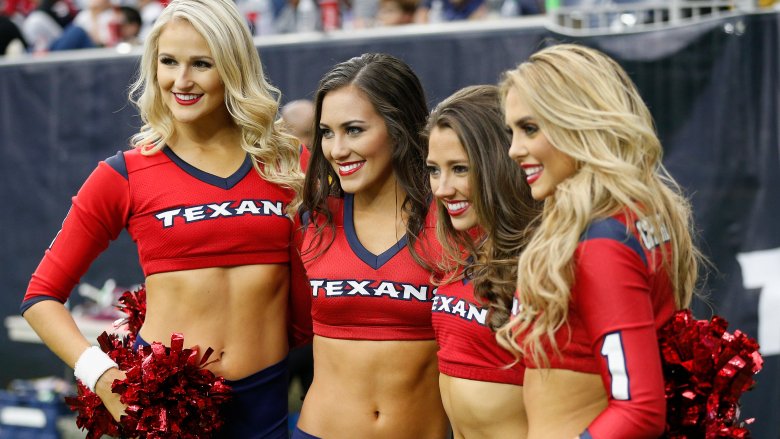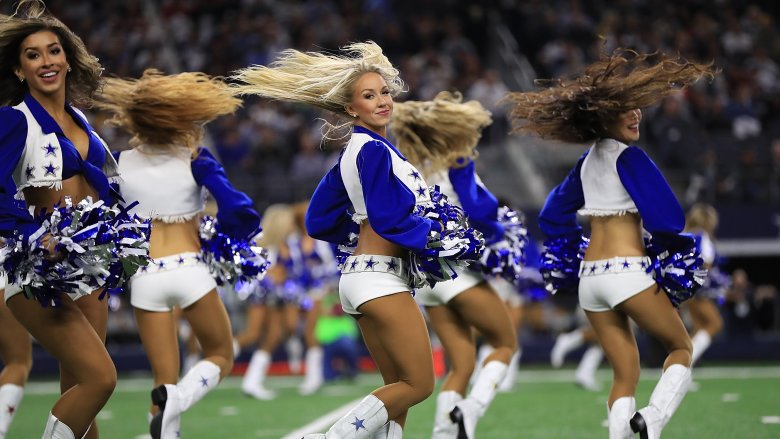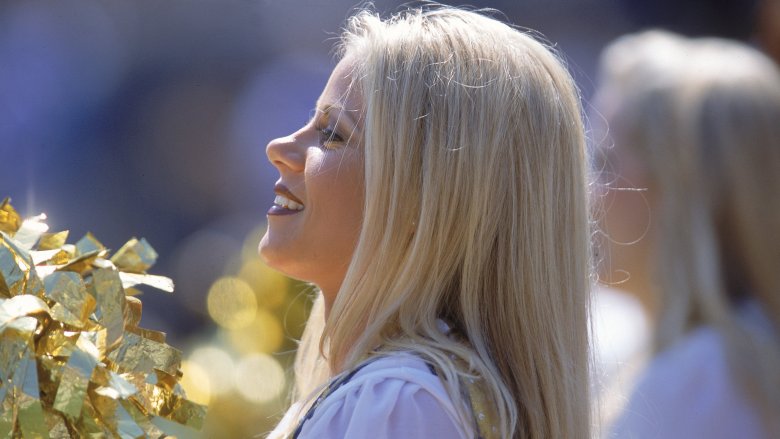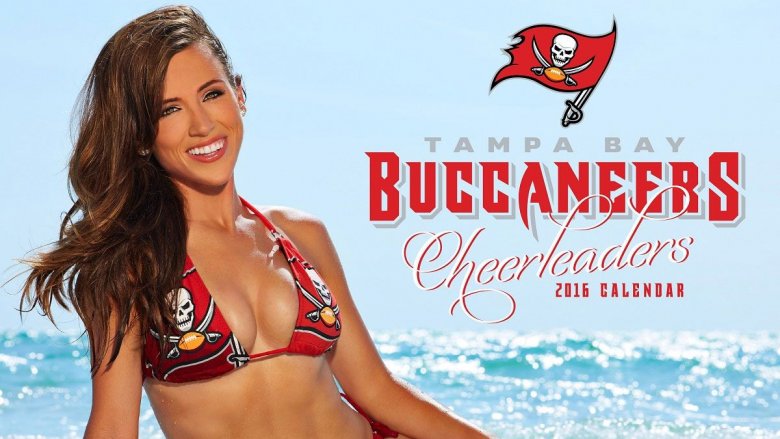Being An NFL Cheerleader: The Ugly Truth
On the surface, the life of an NFL cheerleader looks extremely fun and glamorous. Millions of girls and young women have dreamed of joining famous squads like the Dallas Cowboys Cheerleaders, the Cincinnati Ben-Gals, or New Orleans Saintsations and shaking their pom-poms while wearing tiny but tasteful outfits. Of course, they all hope to perform choreographed dance routines on the fields of NFL stadiums — all in front of thousands of adoring fans who appreciate their athleticism and traditional femininity. (Or something like that, right?)
Cheerleaders get to appear on national TV, be a part of one of the most popular sports and entertainment operations in the world, model for calendars and posters, and support charities. They get to be local celebrities! However, the actual realities of being an NFL cheerleader are problematic, to say the least. Here's the ugly truth behind the big smiles and snazzy dance routines of NFL cheerleaders.
It's an incredibly hard job to get
This should come as no surprise, but professional sports are incredibly competitive. Who wouldn't want the glory, fame, and paycheck that comes from being a star athlete? According to NFL rules, each team can put together a 53-man roster. With 32 teams, that means there can be just under 1,700 NFL players, chosen from a field of thousands of qualified candidates, at any one time.
The talent pool for NFL cheerleaders is just as vast and getting selected is just as competitive. As of 2018, Sportster reports that only 26 of the league's 32 teams have cheerleading squads, and for those precious few positions, hundreds of women in each team's metropolitan area audition. "The [New England] Patriots get more than 500 women who try out for the team every year, and they're all good," former Patriots cheerleader Patty Darrah told Global News. She noted, "You have to walk in, shake hands with people and be able to have an educated conversation. With a major NFL team, they want the best of the best. Which means the best dancers but also the best representatives."
They get paid mostly in the form of adoration
Beginning in 2014, several NFL cheerleaders and cheerleading squads filed huge lawsuits against their teams (and the league) claiming illegal payment practices, such as "wage theft." According to Mother Jones, a suit filed by members of the Oakland Raiderettes claimed cheerleaders raked in just $125 a game — and that's on the high end. The Ben-Gals in Cincinnati were reportedly paid $90 per game, Tampa Bay Buccaneers cheerleaders earned $100, and Buffalo Jills were given a free game ticket and parking pass to home games, which they could sell. Worked out to an hourly wage, and when factoring in things like practice sessions, photo shoots, and personal appearances, many cheerleaders made below minimum wage, which is highly illegal. For the sake of comparison, the average per-game salary of an NFL player around that time: $187,750.
So how did teams such as the Oakland Raiders and Buffalo Bills (subjects of another suit) skirt the law? They reportedly classified cheerleaders as "independent contractors" rather than team employees. After the Raiderettes' suit was filed, the Oakland Raiders upped cheerleader pay to a barely-legal nine bucks an hour. It took a decree from California governor Jerry Brown to ensure that professional sports cheerleaders in that state were guaranteed a minimum wage, along with workers' compensation and other basic benefits.
A uniformly unfair policy
What if your place of employment had a dress code? That's fair — lots of places aim for a certain image or level of professionalism. Now, what if that dress code required you to wear a very specific outfit to work each day, but the only place you could get those clothes is from your employer and they charged you six weeks of pay for it ... and if you didn't buy it and wear it, you'd get fired? It sounds like a scam, but that's exactly what NFL cheerleaders have to deal with.
While the members of many squads make around $100 or so per game, uniforms reportedly not provided. Instead, they must be purchased by cheerleaders from their teams. According to NBC News, those skimpy uniforms would cost a Buffalo Bills cheerleader about $650, and if a uniform suffers even the tiniest bit of damage in the line of duty, the luckless lady may have to pony up for a new one. ESPN reported that a Raiderette had to cough up the cash for a replacement uniform after getting an ink stain on her top at an autograph-signing event.
Weight for it
Regardless of sport or level (high school, college, pro) cheerleaders are almost universally expected to rock a certain "look." They're perky, they're athletic, and their hair isn't too long or too short. But let's be honest: Looking "like a cheerleader" means being conventionally attractive, and, for the conventional and traditional NFL, that basically means being thin.
According to a former NFL cheerleader's anonymous account of her job for Cosmopolitan, svelte figures are enforced by making sure women meet "physical fitness standards," aka weigh-ins a few days before games. "The first time I weighed in at 127 pounds, the choreographer assured me that it was just gas," this ex-cheerleader said. "But when the scale still showed 127 pounds on game day, I was pulled from the performance, even though my family had driven eight hours from my hometown to see me cheer."
Not wanting to be benched for another game (or permanently) the cheerleader said she took a week off from her regular job to focus on dropping weight for the part-time cheerleading gig. She "hired two personal trainers, did three hours of cardio and 30 minutes of ab work per day, and ate nothing but canned tuna and almonds." When the next weigh-in went down, our protagonist had dropped nine pounds and "an entire bra cup size." Hooray?
There's something called a 'Jiggle Test'
While having one's weight checked — and judged — by one's employer is disgusting and demeaning, the realities of work were allegedly even worse for the Buffalo Jills, the Buffalo Bills' cheerleading battalion. According to the New York Post and "Alyssa U.," a Buffalo Jill from 2012 to 2013, the team's cheerleaders were forced to undergo a "physique evaluation."
"We had to stand in front of our coach in our uniform in rows of five as she stood before us with a clipboard," Alyssa said, recalling how their bodies were scrutinized like Lorenzo Lamas with a laser pointer. "We turned around, had her look at our backside, and then turn forward again and she had us do jumping jacks in front of her to see what parts of our bodies were jiggling." The next day, each Jill supposedly received an emailed report of their problem areas, if any. The Jills came up with a name for this dehumanizing and mandatory workplace team-building exercise: "The Jiggle Test."
Their bodies, their choices (J.K., not really)
So yeah, cheerleaders must be thin and bouncy, but those are just a couple of the many strict rules NFL cheerleaders have reportedly had to follow. According to an anonymous cheerleader who revealed all to Cosmopolitan, nearly every aspect of one's appearance was subject to some sort of mandate. "We were required to have nails manicured with light or clear polish," the cheerleader claimed. "We could be pulled from cheering at a game if we showed up with curls when management had mandated straight hair."
Cheerleaders could allegedly get benched if their skin was too pale, too tan, or sunburned. Officials could also supposedly tell cheerleaders to change, say, their hair color, and the cheerleader had to pay for it herself. "I was told to go to a preordained salon and pay out of my own pocket to have my hair dyed a different color," the insider told Cosmo. Why? Management allegedly thought her natural color made her look "too ethnic."
The Buffalo Jills were also allegedly told how to care for their intimate areas. According to Deadspin, the Jills handbook included a section called "General hygiene & lady body maintenance." It reportedly offered tips on what kind of tampons to buy, and how often they must be changed so as to avoid "bacteria or fungus build up."
Sitting on the dock of the pay…
Getting benched for being arbitrarily overweight is one thing, and getting paid barely above minimum wage to help a multi-billion dollar sports franchise make money is another. Some NFL cheerleaders have even had their already paltry pay docked for minor indiscretions. Yep, cheerleaders can apparently earn demerits like new military recruits, prisoners, or Hogwarts students.
In a 2014 lawsuit against the Oakland Raiders on behalf of 40 fellow Oakland Raiderette cheerleaders, "Lacey T." reported that if someone brought the wrong pom-poms to a practice session, at least $10 was docked from their paycheck, reported SF Gate. Among the other offenses that cost cheerleaders real money were bringing the incorrect yoga mat to practice, failing to get their bio into the publicity department in a timely fashion, and not sufficiently cleaning or shining those game day boots. While ten bucks out of a paycheck is certainly annoying, it's also highway robbery considering Raiderettes were only paid $125 a game at the time of the legal action.
Unladylike behavior
Not only do cheerleaders have to keep their appearance in perfect, company-mandated condition, but some are required to conduct their lives off the field according to some severe moral standards that seem like they could just as easily be applied to a 19th century frontier schoolmarm. Among the behaviors the Buffalo Jills were told to exhibit (via Deadspin): Don't use slang, don't swear, "do not be overly opinionated about anything," don't flirt, don't dominate conversations, don't gossip, don't say "I" or "me" too much, avoid any and all sexual innuendo, and don't burp or sneeze without saying "excuse me." According to the Los Angeles Times, Oakland Raiderettes signed a contract promising they'd never wear curlers on their way to to the stadium or chew gum. (Oddly, the Raiderettes are one of the few teams that doesn't specifically ban its cheerleaders from dating the players.)
And while a large part of an NFL cheerleader's job involves dancing in revealing outfits, some teams don't want their cheerleaders doing anything risqué on social media. In 2018, a New Orleans Saintsations cheerleader named Bailey Davis was fired after she posted a privacy-locked photo on her Instagram account in a flattering one-piece (via The New York Times). New Orleans Saints officials said she violated a rule that barred cheerleaders from posting nude, semi-nude, or boudoir pics of themselves. Davis sued the team, which, by the way, also reportedly tells its cheer squad to not even eat in the same restaurants as its players.
Sell that calendar, girls!
In theory, the job of an NFL cheerleader is to use her pep and enthusiasm to inspire the players on her team to do a good job at sports and win, win, win. (Rah, rah, rah, sis-boom-bah!) But they're so much more than that, you guys. They're also team ambassadors and the photogenic faces of their organizations. This puts cheerleaders in the unique position of becoming team merchandise — by posing for cheesecake swimsuit calendars — and then having to sell that merch.
One team that's made calendars of its cheerleaders available for public consumption by hot and bothered football fans is the Baltimore Ravens. Mother Jones reported that the team required each member of its cheer squad to buy at least 100 copies of the calendar at a rate of $12 each. It was then up to the cheerleader to sell them all for $15 per copy. It's like the old "selling candy bars for the youth sports team" scam, except it's arguably sexist and exploits adult women. (The cheerleaders do get to keep the money they make, which almost makes up for the fact that they didn't get paid for the photoshoots that resulted in those calendars, right?)

